
37 minute read
Cover Story
ON THE COVER stellastarr*
PLAYBACK
Advertisement
ST. LOUIS
24
here’s a lot of talk lately about the ’80s sound coming out of New York. You’ve got hype-mongers The Strokes, The Rapture, Interpol, and the Yeah Yeah Yeahs. On the lesser-known side are bands such as stellastarr*, groups who, like the aforementioned, wear their ’80s influences proudly on their tornoff sleeves. In stellastarr*’s case, you can hear shades of The Pixies, The Cure, Talking Heads, The Jesus and Mary Chain, Joy Division. But don’t stop with the inspirations; this New York quartet breathes its own artistic life and energy into every song they write and perform, resulting in a sound that is at once shockingly unique and comfortingly familiar.
One spin of stellastarr*’s full-length self-titled debut and you’re hooked: catchy pop melodies, synth grooves, dreamy instrumentals, and howling vocals. Singer/guitarist Shawn Christensen provides much of the lead work, his voice alternating between soothing, wailing, or roaring. Playing Kim Deal to Christensen’s Frank Black is bassist Amanda Tannen; in addition to her vocal duties, Tannen lays down a mean rhythm undercurrent. The other half of the rhythm section is Arthur Kremer, an Animal behind the drums who also strokes the keyboards and lends the grooves. Rounding out the mix is guitarist and third vocalist Michael Jurin, the fourth and solidifying member of the group.
The roots of stellastarr* were planted at Brooklyn’s Pratt Institute, where Christensen, Tannen, and Kremer first formed a band while attending art school. All three were tentative musicians at best: Christensen, whose first love was art (painting, specifically) followed closely by acting, had only picked up his first acoustic guitar months prior; Kremer was a graphic designer; and Tannen was a classically trained cellist, only turning to bass guitar when she joined the band.
Following graduation, Kremer wanted to form another band. Christensen, who was happy paying the rent via commissions on his paintings, held back, stating he didn’t see music as any sort of reliable career. Eventually, he agreed to the band, but only if two conditions were met: one, if Kremer was able to re-recruit Tannen, who’d moved to Los Angeles, and two, if he found them a truly incredible guitarist. Miraculously, Kremer accomplished both, stumbling across Jurin in one of those only-on-TV moments: the former, a previous tenant of the latter’s apartment, returned to check for lagging mail, and the two got to talking.
Ironically, considering his unique voice and strong stage persona, it was never Christensen’s intention to front the band; he didn’t consider himself much of a singer. Instead, he envisioned stellastarr* (named after a high school classmate whom he never met, the asterisk and lowercase both intentional additions) as led by a female vocalist. As the band came up empty in recruiting a suitable vocalist, Christensen reluctantly tried singing the songs himself; Tannen and Jurin soon followed. “She [Tannen] wasn’t singing in the beginning,” explains Christensen. “Once I started singing, then it was like, well, now it
would make sense if Mandy would sing. Then Michael would come in some times, and there would be three harmonies.” The fact that Jurin had similar influences to Christensen (he was a Jesus and Mary Chain fan, too) only helped solidify the union. stellastarr* made its first splash on the other side of the globe. Initially signed to U.K.- based indie label Tiswas Records, they released their debut EP, Somewhere Across Forever, in December 2002. The band quickly received accolades from the British press, including New Musical Express, which proclaimed them “a band with wit, imagination and a knack for hooks.” As for why they broke in the U.K. before their home country, Christensen says, “That’s just how the stars aligned. It’s all about radio play in America, whereas in the U.K., if you were never on the radio and you got nothing but press, I think you could still sell out certain venues.”
Returning to the States, the four, like so many bands before them, made the spring pilgrimage to Austin, Texas, for their first foray into the musical showcase that is South By Southwest. A nearly unknown band at the time, they were one of the highlights of the festival. “The first trip [to SXSW] was pretty exciting in the aspect that we’d never really left New York before, and we’d never been at a festival. So when we went to Texas and [our show] was sold out, and we were approached by all kinds of agents and labels, it was kind of a shock. Also when we went down there, we had a lot of press: we were in the Austin Chronicle, and we were in all these publi
March 2004

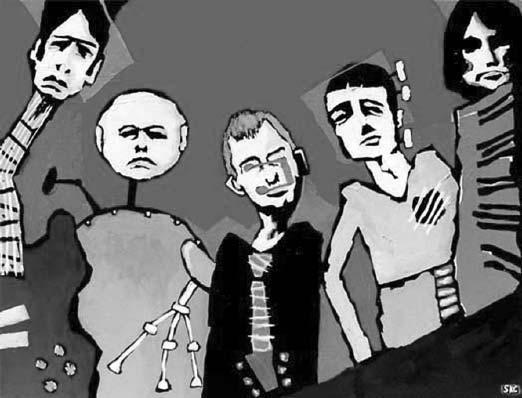
cations, and it was just very odd to us. I guess our view of festivals was that they were just a melting pot of a thousand bands basically just getting lost in the shuffle. We didn’t think anyone actually paid attention.”
But pay attention they did, and stellastarr* soon found itself being courted by record labels and industry press. They signed to RCA Records and in September released the self-titled tensong gem. In that month’s Playback St. Louis, I offered the following observation: “The sounds aren’t entirely new; they’re familiar, put together in a new fashion. The voice is strong and reminiscent of many who have come before—Jarvis Cocker of Pulp, Russel Mael of the Sparks. The music is exquisitely strummed or keyed or drummed or otherwise coaxed.” Alternative Press named stellastarr* as one of the 100 bands to know in 2003.
Though the band has been accused of being too “retro,” Christensen insists it wasn’t intentional; it’s just what he grew up on. His theory is that the influences of childhood are the ones that remain, whereas other phases in your life merely burn bright and then fade away. “What I believe is that you can’t escape nostalgia; nobody can,” he told me. “Ultimately, songs you heard when you were five or six or eight or nine, however old—when you’re in the car, on your way to school, or on the bus—those kinds of things,
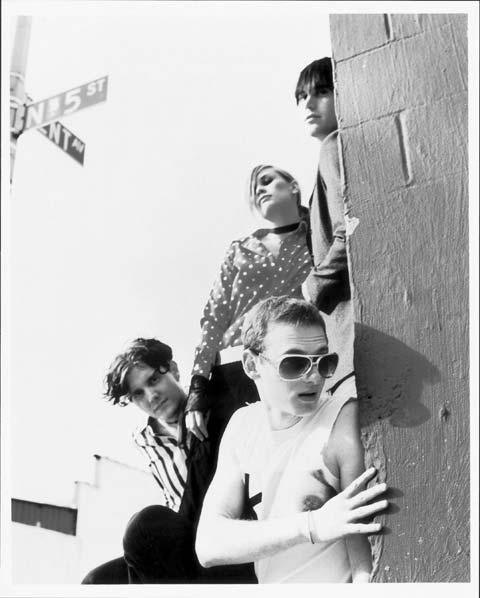
“I didn’t really listen to [music] until the early ’90s,” Christiansen confesses. “I just wasn’t into it; all I was into was drawing, really.” In fact, Christensen set out to be an artist, attending New York’s Pratt Institute to further his art skills. If not art, then he figured he’d fall back on acting, finding music to be so uncertain. “I never could take it seriously as a career because it’s such a shifty industry,” he says “How can I ever feel secure in this industry?”
Asked how much time he still has for art, Christiansen admits, “I still get commissions from people to do things. I’m painting the Libertines right now for somebody, just because that’s a lot of money right there and I’m not doing anything anyway besides rehearsing. It keeps me with a paintbrush. I don’t really do much of what I want to do—I did the album art, and I do some things that deal with the band here and there, but that’s about it.
“I had to make a conscious decision to sort of combine acting and painting and music,” he continues. “Before that, I was sort of splitting myself into thirds, you know? I was sort of a jack of all trades but a master of nothing. It didn’t really work out until I realized that I had to combine them all together in order for anything to really be prosperous.” Hence, the effervescent stage persona was born, wherein Christiansen combines his acting and artistic qualities with his music.
Regardless of his creative talents, Christiansen has a strong work ethic and manages his gifts with an eye toward the business end of things. He sees his “job” as a combination of fun and work: “It’s like fun work. Since I’m doing what I want to do, the creative thing, the answer is yes, it’s fun, but also I’m very, very, very frugal about the business side. I really pay attention to that thing, and I can’t afford not to. And it might be a little bit of a pain in the ass for maybe our manager or people on our team for me to know everything that’s going on, but that’s the way it’s gonna have to be.”
See for yourself: www.shawnyboy.com.
BY SHAWN CHRISTENSEN SID VICIOUS RADIOHEAD , AND BJORK , PAINTINGS:
25
bad or good, they’re going to stick with you. If you’re keen enough to weed out what the good aspects are, you can be really on to something, because you can’t really escape those things; those are subconscious, I think. Since all of us were that age growing up and listened to similar music, I think we subconsciously write those kind of passionate songs.
As for where the band is headed—or if they’ll even know what it is when they arrive— Christensen is vague. “I still don’t know what ‘made it’ means for me right now,” he admits. “But where I felt that we had really broken some ground was when we got some radio play in the U.K. and we started selling out shows over there. And then when we signed over here to a label, I think that’s when we realized that, OK, this is something that we’re going to be doing for the next few years, and we’ll be happy doing it.”

In the end, the conglomeration of art and music has resulted in a sound that is at once unique and familiar and catchy as hell. The stars fell into alignment with this group; truly, there is no better configuration for this band. Indeed, it’s impossible to imagine the band led by anyone other than Christensen, with his distinct, defining voice and commanding presence. Still, I asked him to imagine what stellastarr* would be today if they had found the female singer they’d been seeking. “I think it would actually be too similar to a lot of other bands,” he says. “Now there are so many bands with female singers in them…so maybe it was better that we didn’t go that route.”
He won’t get any arguments from me; I wouldn’t change a thing.
Check out stellastarr* for yourself at the Gargoyle on April 17.
NOW PLAYING CINEMA
PLAYBACK
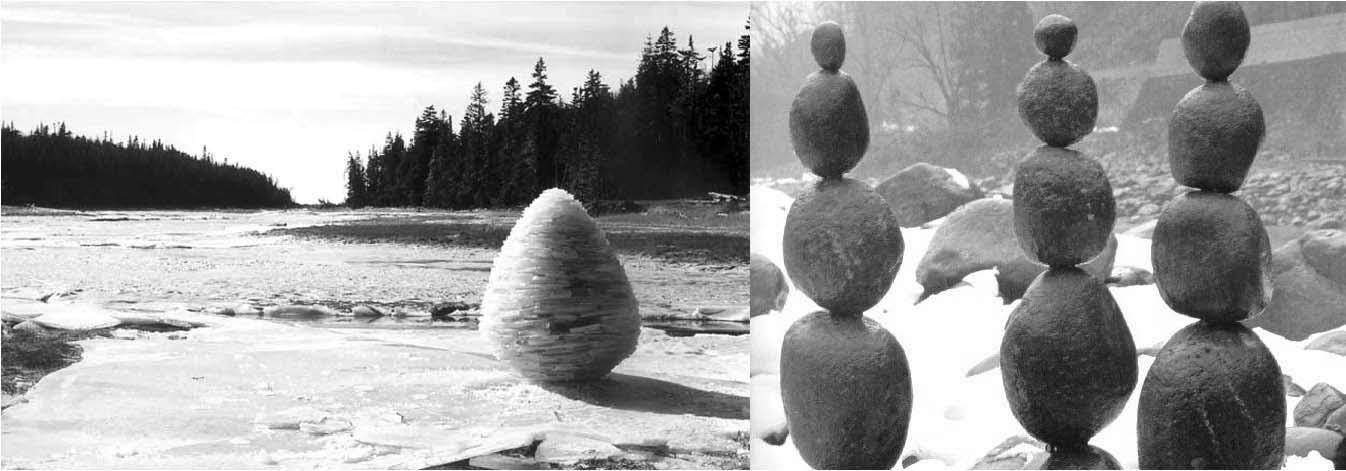
ST. LOUIS
26
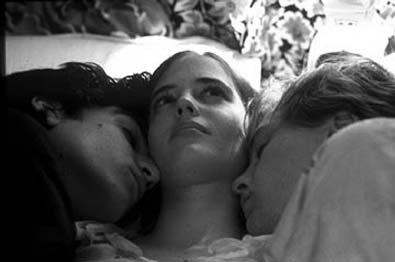
RIVERS AND TIDES: ANDY GOLDSWORTHY WORKING WITH TIME (Not Rated)
Filmmaker Thomas Riedelsheimer spent a captures the pieces of the moment and condensMatthew (Michael Pitt) to stay at their luxuriyear with artist Andy Goldsworthy and his es time around the established installments. ous Parisian villa while their parents are away works. The resulting film, Rivers and Tides: Riedelsheimer’s film brings Goldsworthy’s on vacation. Set loosely against the backdrop Andy Goldsworthy Working With Time, beautiwork to life. Riedelsheimer takes the viewer of the student-worker revolt in Paris in 1968, fully depicts the artist’s works. Goldsworthy speplaces most actual visitors never see. Arial shots the bulk of the film is a series of fairly graphic cializes in creating sculptures from natural found of long constructions, time-lapse composites sexual encounters and circumcoital conversamaterials. He enters an area and communes with of seasons blooming, and falling around stone tion—heavily salted with film history, ’60s rock, the surroundings, drawing on the power of the cones provide a different perspective and new and talk of revolution. place. His sculptures range from lengthy stone insights. Fred Frith’s plunky soundtrack counThe basis of the love triangle is anchored by walls to delicate lengths of petals floating on terpoints Riedelsheimer’s vivid camera work. a game of film history charades. In what makes water. Some of his works come and go in the Frith’s almost atonal combination of Australian for an interesting and engaging filmic device, blink of an eye; others stand as monuments, but Aboriginal tones and Native American music Bertolucci intercuts the scenes being reenacted organically arising monuments. sets the languid pace of the film. The haunting with the corresponding archival footage of Greta
The film consists of footage of Goldsworthy score seems found and assembled, much like Garbo, Jean Seberg, and the like, involving the working and discussing his process and of beauGoldsworthy’s works. viewers in the game implicitly. Film buffs may ty shots of his completed works. Goldsworthy’s This is a wonderful film about both enjoy the challenge but may or may not be happy dialogue continues as he works and in interviews Goldsworthy’s artistic process and the artistic to find out the penalty of an incorrect guess: a after the process. He thoughtfully attempts to process in general. It is filled with serene visuals bizarre sexual act. explain his work without resorting to esoteric and poignant commentary, weaving not so much Unfortunately, the resulting sex scenes are clichés. A down-to-earth guy, Goldsworthy even a story as a study. somewhat perplexing and unsexy; they seem mocks those clichéd answers that explain nothRivers and Tides plays March 5 through 7 at to be characterized by misguided attraction as ing and save the artist from actually examinthe Webster University Film Series. opposed to genuine chemistry. It’s not coming his work and process. He genuinely tries —Bobby Kirk pletely unpleasant to watch, if you don’t mind to explain how he comes by his art; often he the copious (mis)use of body fluids and get a rambles or searches for the answers, but that is T HE DREAMERS (Fox Searchlight Pictures, kick out of the Greenaway-like juxtaposition of because what he is trying to explain is esoteric Rated NC-17) sex and fried eggs; there is a sort of tension that and ephemeral. When Goldsworthy does find The Dreamers is being released in the U.S. in is maintained by the hope that something useful the words, he is eloquent, offering insights into its full, uncut form by Fox Searchlight Pictures will come of all this, and the cast is attractive art, life, and humanity. with a mildly controversial NC-17 rating. Peter enough to be forgiven for their seemingly per
Because Goldsworthy’s works are so comRice, president of Fox Searchlight, proudly petual nudity. pletely connected to the time and place of their defends the decision by likening the new film Between sexual episodes, the characters creation, they are difficult to experience by a to such uncut and formerly X-rated classics mostly lie around in various states of undress mass audience. Rivers and Tides’ spectacular as Schlesinger’s Midnight Cowboy (1969) and while debating the topics du jour. While some cinematography brings these works to that wider Bertolucci’s own Last Tango in Paris (1972). audience. The irony of Goldsworthy’s works is Certainly one can’t fault the studio for placing most of his pieces fall into two categories. The The Dreamers in the same company as the direcfirst are projects that come and go before anyone tor’s own Last Tango in Paris, but unfortunately, ever sees them, such as a sculpture of icicles or the comparisons between the two films are a bit leaves in a river. The second are massive structoo plentiful—it has already been joked that The tures often of stone that, while stoic in their Dreamers might more aptly be named First Tango nature, change with time as the seasons or tides in Paris—and one wonders if this metaphorical warp the world around them; consequently, they town is big enough for the both of them. take years to experience. Both types are difficult The Dreamers is ostensibly a story of sexual to view, the first because they are completely of and intellectual discovery in which the vaguely the moment, and the second because they are incestuous brother-and-sister team of Theo Louis Garrel, Eva Green, and Michael Pitt in only revealed over lengthy periods of time. This (Louis Garrel) and Isabelle (Eva Green) invite the menage a trois–driven The Dreamers. Photo is where the film succeeds. The magic of cinema lonely young American and fellow cinephile courtesy Fox Searchlight.
March 2004
of this conversation makes for some of the best moments of the film, the characters are unfortunately afflicted with the sort of pseudo-intellectual cleverness that comes from a script that is overly ambitious and symbolic while not particularly deep.
Thus the overall effect of the film, despite a handful of excellent moments, is a caricature of tantalizing concepts that are squeezed out by overly prominent body parts and fluids. One wishes, at times, that the superficial trio would just cut the cleverness and lame attempts at romance and join the revolution that they love to discuss so lavishly. —Marc Syp
G REENDALE (Shakey Pictures, Not Rated)
Neil Young has never won a Grammy or an Oscar, but if awards were given for sheer artistic vitality, he would be overdue for a lifetime achievement honor. This legendary Canadian singer/songwriter/guitarist/filmmaker and outspoken humanist has been confounding expectations and continually redefining his art for nearly 40 years. Greendale, Young’s new multi-format work, has to be considered a real surprise even to longtime aficionados. First, Young presented the ten songs that make up the work in an intimate acoustic show in Dublin. Then he launched a full U.S. tour with a cast of characters who lip-synched and acted out the songs, while Young and Crazy Horse performed them. Then a CD of the songs was released, with a companion DVD of the Dublin show. Now comes Greendale, the movie.
Greendale is the fictional story of a multi-generational American family, the Greens, beset by hard times and the quirks of fate that end up bringing unwanted media intrusion into their lives. Young uses his characters and his potent, guitar-driven songs to paint an evocative picture of modern life gone awry, corporate greed and political turmoil draining the spirit, and out-of-control media bent on capturing a story regardless of personal toll.
As each song plays, characters mouth the lyrics or simply act out the situations described. In “Falling From Above,” Grandpa and Jed sit on the porch with the paper, chatting about the world and how “a little love and affection/will help to see you through.” In “Double-E,” Sun Green takes notes on a television broadcast about the environmental threat to Alaska. In the truly poignant “Bandit,” Vietnam vet Earl Green unsuccessfully tries to peddle his psychedelic paintings. And in “Devil’s Sidewalk,” the Devil himself bops around in various places, including a schoolyard, where hot young cheerleaders cheer on the “Fighting Demons.” When Jed impulsively shoots a cop who stops him for speeding, news crews swarm the Green property to interview Grandpa, with dire results. The film builds to a climax in the songs “Sun Green,” where the newly energized young woman heads for Alaska with a comrade to fight the good fight, and “Be the Rain,” where the whole crew is shown onstage dancing and pumping fists into the air. It’s a story of ethics and heartfelt values versus corruption and government oppression. News clips of John Ashcroft and Osama bin Laden make it clear that this is today’s world.
The film is grainy, lending an intimate home-movie feel to the proceedings, while all the news footage is crisp and clear. Greendale is essential for fans of Young’s music and should prove compelling to most others. Young only appears in the film briefly, but his indomitable spirit informs every frame of this film. Young’s wife Pegi plays Edith Green, and Ben Keith, Young’s most enduring musical sidekick, plays Grandpa. Directed by “Bernard Shakey,” Young’s well-known cinematic alias, Greendale’s camera work itself may be a bit shaky at times, but Young’s compassionate vision of an America in jeopardy never falters.
Greendale will be shown at the Tivoli Theatre from March 5 to 11. —Kevin Renick
THIS MONTH ON WWW.PLAYBACKSTL.COM: • Bobby Kirk’s review of the True/False Film Festival in Columbia, Missouri. • Kevin Renick’s review of On the Ropes (Paramount).
STEREOLAB IS COMING TO TOWN AND YOU CAN SEE THEM FOR FREE! WIN ONE OF TEN PAIRS OF TICKETS BY SENDING AN EMAIL TO M ARGERINE@PLAYBACKSTL.COM AND WE WILL SEND YOU AND A FRIEND TO THE THURSDAY, APRIL 8 SHOW AT THE PAGEANT (WE WILL EVEN THROW IN SOME COOL EXTRAS!)
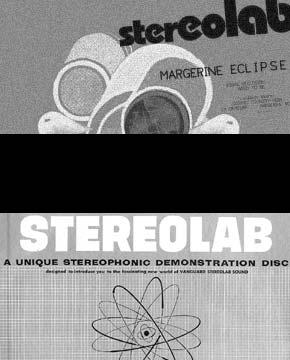




Come see the truly spooky movie The Lost Skeleton of Cadavra featuring a loopy cast of characters including the beautiful cat-suited Animala, the lovable Dr. Armstrong and his charming wife Betty, sinister Dr. Roger Fleming, out-of-this-world couple Krobar and Lattis (along with their mutant pet), and, of course, the power-mad Skeleton who wants to rule the world. Playback St. Louis and Landmark Theatres invite you to a special sneak preview of this classic (or soon to be classic) horror fi lm. WEDNESDAY, MARCH 10 • 7:30 P.M. at The Tivoli Theatre ~ In the heart of the Loop Pick up your FREE tickets at these Playback St. Louis distribution locations: All Borders Locations • Einstein Brothers Bagels (Richmond Heights) • Kayak Coffee (Skinker Blvd.) • Euclid Records • Crazy Bowls and Wraps (Clayton and Lindell locations) • Star Clipper • IronAge Tattoo • Slackers CD & Games or e-mail us at: events@playbackstl.com
27
PLAYBACK
ST. LOUIS
28
Play by Play
the music around what’s swirling around in his psyche and less from his influences—or, at the very least, use them with more subtlety. —Cory Hoehn
J AMES LAVELLE: ROMANIA #026 (Global Underground)
In 2002, James Lavelle took time out from his crazy schedule to record a DJ set in Barcelona for Global Underground’s DJ mix series. It was an amazing set filled with punchy electronic beats, tribal breakbeat sounds, and acid house melodies. Lavelle was at the top of his game.
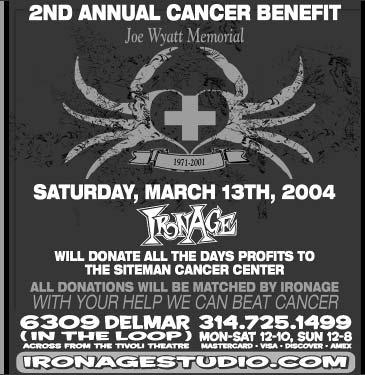
SM

SM Lavelle is back at it again with his second Global Underground foray, Number 26 in the series, entitled Romania. The set was recorded last December in Bucharest at Studio Martin. Romania was selected for this gig because it has superseded Budapest as the epicenter of Balkan club culture. Romania is booming socially and economically. As a result, it is the latest Eastern European country to have a re-energized club scene.
Romania is neatly divided into two halves, one entitled “Beauty” and the other “The Beast.” Both halves form the core of a hard-as-hell set that moves from a rock-oriented beginning into to an abstract, blippy middle and a crunchy, houseflavored end. The “Beauty” side is the rockier sounding of the two halves. Lavelle believes rock music has a place on his dance floor and begins with his own remix of Queens of the Stone Age’s “No One Knows.” This moves into some UNKLE songs before finding DJ Shadow’s beat-heavy crusher “GDMFSOB.” Before settling into more experimental sounds, disc two unleashes Brit popsters Ian Brown and The South into the mix.
Lavelle likes to push the boundaries. He builds upon the more rock-based sound of disc one and carries it into a more melodious-sounding second half. “The Beast” is funky, fresh, and lively. Lavelle quickens the pace here, spreading it out on the horizon. He opens with a faint hum that rises into Richie Hawtin’s paranoid masterpiece, “Ask Yourself,” then gets into some downright sweaty tracks by Craig Richard and UNKLE (again). You can almost hear Bucharest boogieing as things accelerate with Peace Division’s “No More Subliminal Shit” before plunging onward, eventually settling the set into the house music bliss with the “Don’t Funk” by Photek and culminating with the Chemical Brothers/Flaming Lips confab “The Golden Path.” After that, the adrenaline slows down, collapsing finally with UNKLE’s quieter “In a State.”
DJ mix CDs are tricky little bastards to listen to. They are circumspect because very seldom do they deliver the goods from track one through until the very end. Romania sidesteps this dilemma because Lavelle mapped out a set that avoided redundancy, while building layers of sound that smoothly transitioned into each other, carefully sculpting a tempo that was never excessive or overbearing.
James Lavelle’s next project is a new fulllength from UNKLE entitled Never Never Land. —Rob Levy
from page 13
L IL JON & THE EASTSIDE BOYZ: PART II (TVT)
With OutKast and Ludacris as notable exceptions, Dirty South rap’s biggest successes have been with incredible beats and simple, sometimes downright stupid lyrics. Cash Money Records’ platinum-selling back catalog consistently breaks every cardinal rule of rhyme, epitomized in Juvenile’s breakthrough single, “Ha.” Every line in “Ha” ends with that word, thus circumventing the actual need for the lyrics to rhyme. Not that there’s anything wrong with that; Juvy’s crazy southern drawl and Mannie Fresh’s beat easily outweigh the questionable lyricism. Therein lies the blueprint for Lil Jon’s brilliant, unapologetic party music: make gigantic, bass-filled beats and shout over them, occasionally bringing in all-star emcees to contribute verses.
Part II is a CD/DVD pairing that sells for the price of one disc. The EP is a reasonable seven tracks long, although not quality front to back. “Get Your Weight Up” features TI and 8-Ball, and TI kills it from the gate. Lil Jon’s beat has a somewhat hokey twang to it, but suits the rap well. The “Put Your Hood Up” remix features Jadakiss of The Lox, the most reliable guest emcee in the game right now (see Ghostface’s “Run” or Gangstarr’s “Right Where U Stand”), and, for no good reason, an intro by the light heavyweight champion of the world, Roy Jones Jr. The “Throw It Up” remix features the unremarkable Pastor Troy and G-Unit’s weakest link, Young Buck, but manages dopeness with a beat that flips a Kronos Quartet melody. The other four tracks are mostly forgettable. Busta Rhymes and dancehall star Elephant Man show up on a dull remix of the hit single “Get Low,” which is then remixed again in a merengue fashion featuring Pitbull. TVT labelmate Oobie does her best impression of StL’s Toya on an out-of-place “Dirty Dancin,” and while Chyna Whyte sounds better than usual on “What They Want,” she’s still kind of boring.
While the CD has some good tracks, the DVD is worth the price alone. In reverse order, this is all of Lil Jon’s videos from the last few years. The premise of his videos is as simple as his music: take a whole bunch of people and film them getting crunk to a Lil Jon track. “Put Your Hood Up” is far and away the best, putting the party in an elementary school setting. They get crunk on a schoolbus. They get crunk on the kickball field. Bay Area legend E-40 shows up in an ice cream truck and does homage to Big Worm in “Friday.” “I Don’t Give a Fuck” is the most advanced, as one long steady-cam shot follows the crew
March 2004
through a crowded club. Mystikal spits his guest verse from a urinal. The “Behind the Scenes with the Kings of Crunk” feature is the only disappointment on the DVD, mixing together basically random shots of award shows, backstage footage, concerts with low sound quality, and the obligatory inside jokes. A shot from the Source Awards nomination is an embarrassing highlight, as the viewer watches New York emcee Fabolous (sic) struggle to read his set of nominations.
Simply put, Lil Jon and the Eastside Boyz make the 2004 equivalent to Bon Jovi’s “Livin’ on a Prayer”: simple and effective party music, music to howl when drunk. Part II is a cheap, high-quality slice of crunkness, with some decent tracks and a classic DVD. —Andrew Friedman
L UDO: LUDO (Redbird Records)
Congratulations, Ludo! You have recorded an album. Now you can sell copies to your friends and to the adolescent poppunk demographic with whom you are obviously attempting to identify. Now you can tell your parents and relatives that you finally accomplished something and reimburse them for purchasing your guitars/bass/drums. Now you can dwell in the memory of having played at the Pageant. Now you can claim more success than the other 130 bands in St. Louis that sound just like you. And now you can stop playing. Please. Just stop.
The 11-song, self-titled CD is bearable at best. The vocal melodies are repetitious; the guitar techniques are juvenile; the rhythm section is simplistic; and the song structures are predictable. (Oh, a reggae-influenced verse into a slamming chorus? How clever.) I became weary of the self-proclaimed “soaring melodies” by the third and most commercially adaptable track, “Hum Along.” Other tracks, such as “Good Will Hunting by Myself” and “Laundry Girl,” are reminiscent of Weezer without any level of sophistication. Note: Having musical ability is as important as having witty lyrics.
The lyrics, ranging between clichéd (“I watch time slip away” from “Summertime”) and ridiculous (“There’s a party-thumpin’ booty-humpin’ music wagon in my head” from “Saturday Night Thunderbolt”) may amuse you once but probably for the wrong reasons. The inside jokes and odes to former girlfriends (the CD’s obnoxiously recurring theme) will forever entertain the boys in the band, but for those of us on the sidelines, there’s no fun in being a spectator.
I’m not saying that no one can have fun writing and recording music. And I’m not saying that humor has no place in music. I’m just trying to point out that if bands take themselves seriously and want to, as Ludo’s press kit states, “continue their rapid rise to the top,” then the bands have to take into consideration how high that ceiling is and whether they’ve already hit it. —Jeff Church
M ILTON MAPES: WESTERNAIRE (Aspyr)
Is there really an American music? I think there is, and Austin’s Milton Mapes comes from a generation weaned on Americana (read: alt-country): technologically savvy but with a rhythm adjusted in the heartland. On this disc, you will hear traces of Wilco, R.E.M., Waylon, and Willie, with odes to Autry, Cline, and Rogers. The music portrays an endless horizon and a lonesomeness that seems odd in this world of effortless connection. This band, named for founder Greg Vanderpool’s grandfather, paints aural landscapes that feel hot and dusty, with the promise of home just around the corner. The band also includes Roberto Sanchez, Ty Chandler, Jeff Jones, and Chepo Pena.
The songs on Westernaire remind me of Nashville’s Glossary in their recurring themes of want. The allusion to a porch light left on, waiting for that sound of return in “The Only Sound That Matters” is painted in deceptively simple terms, yet it speaks volumes about the subjects in the song: the dance that is a relationship and the symbols that we use. “Just like a backlight, too/It’s your protection/And she’s leaving it on/ She is waiting for your return/The only sound that matters.” Vanderpool has the geography of a great empty country upon which to build his lyrics. He does so with a steady, unrushed momentum. The effect is like a soundtrack for a cross-country drive. Images pass in the car window—from cactus to mountain, from mountain to ocean—voices in a darkened car, stories not so much riveting as they are soul food.
There are very few missteps on this album; it has a grandeur that makes it “easy listening” in the best sense of the phrase. The only point at which I found it a little disjointed was the song “This Kind of Danger.” It seemed that, when the band tried to pick up the tempo, they lost their timing. I guess every road trip soundtrack needs a pit stop; this one was hardly a bump.
Milton Mapes’ Westernaire offers what people have searched for throughout history—the rapidly vanishing America that is there if we only just listen for it. —Jim Dunn
continued on next page
GET IT HERE!

Playback St. Louis is available in nearly 400 locations and by subscription. It is everywhere you go, filled with reviews, previews, and interviews about music, art, movies, books, theatet, and more. Visit these locations (and nearly 300 others) to pick up your copy. BALLWIN/ELLISVILLE/ MoKaBe’s MANCHESTER Wherehouse Music Crazy Bowls & Wraps SOUTH COUNTY Enigma Lounge Guitar Center Crestwood CENTRAL CORRIDOR SLCC - Meramec Farotto’s Streetside Records - Focal Point Crestwood JackSon’s UNIVERSITY CITY Kayak’s Iron Age CENTRAL WEST END Pageant Raccanelli’s Rag-O-Rama Schlafly Library Tivoli Strata WEBSTER GROVES 34 Club Euclid Records CLAYTON Imo’s Breve Webster Univ. Crazy Bowls & Wraps WESTPORT Einstein Brothers Bagels Starbucks CREVE COEUR Trainwreck Saloon Pink Galleon ILLINOIS DOGTOWN BELLEVILLE/SWANSEA Spaghetteria Mama Mia Lincoln Theater DOWNTOWN/MIDTOWN Quebec City Bistro Sheldon Concert Hall Southwestern Illinois College SLCC - Forest Park COLLINSVILLE/EDWARDSVILLE SLU (Busch Memorial Milo’s Cigar Shop Center) Mojo’s Music Studio Café SIU-E Swifty’s FAIRVIEW HEIGHTS Velvet Funny Bone FENTON/ARNOLD GRANITE CITY Enchanted Dragon Vintage Vinyl Gravois Grill O’FALLON/SHILOH/LEBANON KIRKWOOD Brewers Einstein Bagels Dr. Jazz Ice & Fuel McKendree College Now Hear This SAUGET LACLEDE’S LANDING Oz The Sundecker’s Pop’s Mississippi Nights OUTLYING AREAS NORTH COUNTY CHAMPAIGN-URBANA Guitar Center Bridgeton Cowboy Monkey McMurray Music Highdive SLCC - Flo Valley COLUMBIA, MO UMSL - Millennium Center Blue Note SOULARD Cherry Street Artisan Lil’ Nikki’s Mojo’s Off Broadway Music Café The Way Out Club O’FALLON, MO SOUTH CITY Too-Relaxed Frederick’s Music Lounge SPRINGFIELD, MO KDHX Mud House If you don’t see Playback St. Louis in your favorite hangout and want to have it there, call us at 314-630-6404 and let us know. We will add it to our list and send you a special prize. To subscribe to Playback St. Louis, send $25 for a year’s subscription to: Subscriptions, Playback St. Louis, PO Box 9170, St. Louis, MO 63117.
PLAYBACK
ST. LOUIS
30
Play by Play
MOUNTAIN GOATS: WE SHALL ALL BE HEALED (Matador)
“Here they come/the young thousands/here they come/the young thousands.” After generating numerous lo-fi releases in relative obscurity during the past decade, the Mountain Goats are starting to garner a much larger response with recent albums. We Shall All Be Healed represents yet another step toward a deeper, more complete musical sound with much higher production values. The result is a consistent record that retains singer/guitarist John Darnielle’s intriguing lyrics throughout the piece. Dark, mysterious lines such as “There must be diamonds somewhere in a place that stinks this bad” are commonplace across the record.
Darnielle crafts tales of lonely souls struggling to stay afloat while rarely stating anything directly. Presentations of isolation within dirty and bleak environments exist within each track, yet it becomes difficult to discern a linear tale anywhere. There is definitely little overt Springsteen territory being covered in these songs. The album begins with haunting strings backing the melodic acoustic guitars of “Slow West Vultures,” which wonderfully paints a troubling, yet possibly hopeful future. Darnielle’s unique nasal delivery seems to disguise much of the depressing elements and provides at least room for slight optimism. However, his words remain puzzling and stuck within the enigmatic aspects of the human psyche.
We Shall All Be Healed may cover some difficult territory, but musically it includes numerous attractive moments. “Letter From Belgium” features a driving guitar beat that will have listeners singing right along, even if the lyrics discuss “chewing our tongues off.” A piano tune supports “Your Belgian Things” and injects an added emotional context to Darnielle’s vocals. Devotees of the Mountain Goats’ early work might long for the early hiss-filled cassette numbers, but they shouldn’t discount this impressive record. Nearly every song paints a distinctive story and causes our imagination to flow in countless directions. —Dan Heaton
G RAHAM PARKER: YOUR COUNTRY (Bloodshot Records)
You think you know somebody. You figure you’ve been a fan for some 25 years and you know every album pretty much by heart. And then, Graham Parker goes and puts out a country album on you. Okay, so maybe not strictly a country album, but I don’t remember hearing
from previous page
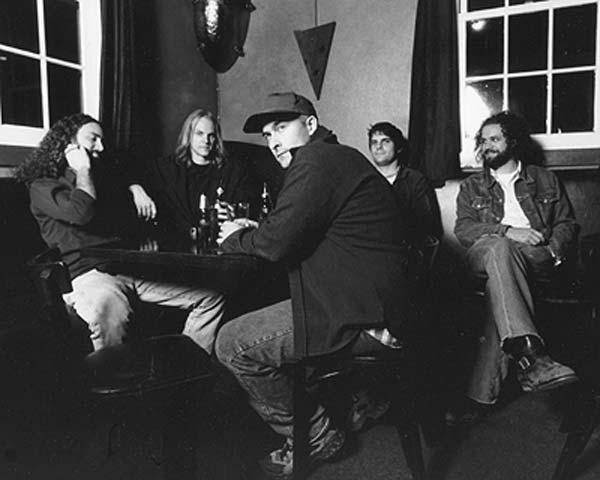
a pedal steel player on any of those classic English Pub Rock records he made in the ’70s.
For Graham Parker fans, this album is a bit of a departure, but it shouldn’t come as any real surprise. He is one of a Milton Mapes. Photo by Robyn Eden. very small cadre of artists who have managed and I find their creative aesthetic—whatever it to stick around this long without trading on is—quite compelling. For one thing, it’s stark, past glory. If you picked up 2002’s Deepcut to right down to the cover art: their first album Nowhere, you already know that Parker has only depicted a bleak, overcast day at the ocean; their gotten better with age on all fronts: vocals, musinew one, In One-Hundred Years the Prize Will Be cianship, and songwriting. Country is not a style Forgotten, features an off-green pattern that looks of music Parker is typically associated with. There like the tablecloth used when no guests are comhave always been traces of Motown in his songs, ing over or the neighbor’s curtain that’s drawn but never Nashville. Listen to Your Country, most of the time. however, and you realize he would not be so out I could be wrong, but I think The Potomac of place walking along Music Row. Songs like Accord’s curtains are indeed pulled most of the “Cruel, Cruel Lips” and “Anything for a Laugh” time. This is an introspective, sort of mysterious make him sound as though he’s been there all group, and they don’t get much publicity. They along, as does the swing he puts to his cover of don’t even play live that often. But hey, if you Jerry Garcia’s “Sugaree.” needed someone to score your film, especially Still, there are other songs that are more one with a lot of slowly shifting, unsettling imaglike the Parker we know and love. “Nation of es, these guys should be on your shortlist to call. Shopkeepers” and its lyrics about being from Their music is very cinematic, and Andrew Benn England show that even though he may be briefly (piano, vocals, guitar) knows his way around a straying from his musical roots, his heart is still piano—both the white keys and the black keys. in his homeland. Country music fans, however, He plays majestic chords, chords that rise and are perhaps the biggest benefactors of Parker’s fall, chords that march forward in a stately manforay into this style of music, if for no other ner, gain in intensity, and drop back. There is reason than Parker could single-handedly stop enormous assurance in Benn’s playing, and he’s country music lyrics from being the butt of so an utter master of the art of repetition with slight many jokes. variations. This can be tedious, of course, as —Wade Paschall Benn is content to sustain the melancholy mood here for quite a long time. T HE POTOMAC ACCORD: IN ONE-HUNDRED So it’s a good thing that founding member Y EARS THE PRIZE WILL BE FORGOTTEN Jerry Green is there to play some precise, crisply (First Flight) recorded percussion and occasionally rock things I don’t know about up a bit. New bass player Michael Lorenz and you, but I think every violinist Samantha Bendet are also there to add metropolitan music diversity to the textures. But musically speakscene needs at least ing, this is mostly Benn’s show, and he sings one moody, pianoon nearly all the tracks. Benn has a gentle if centric, shoegazunremarkable voice; he delivers lyrics with pretty ing, cinema-loving, much the same confidence with which he plays. conceptually vague, Sometimes the emotionality of his vocals lures perspiring, aspiring, you in deeper, and sometimes, honestly, it simply sometimes haunting, sometimes boring bunch grates. Whether it limits the commercial potential of methodical musical introverts. Not all cities of The Potomac Accord is debatable, but I give have such a thing, but I’m really glad that St. this band the benefit of the doubt because they Louis does. They’re called The Potomac Accord, sound like no one else around here, and I’d rather
March 2004

have a band aspiring to heights of contemplative Dualtone Records has issued No Depression: beauty and getting there at least half the time What It Sounds Like Vol. 1, which makes a fine than a bunch of smug rockers who might be more intro both to the music that magazine celebrates charismatic or crowd-pleasing. Also, their work is and, by extension, to the magazine itself. exceptionally well recorded and mastered. “[W]e’ve gathered this baker’s dozen of songs
TPA tends to be most memorable in moments: that have moved and inspired us over the years, the spooked finale on opener “A Quiet White Cut to perhaps offer some aural focus to our vision by the Longest Blue Shadows” (love your titles, of alternative-country music,” No Depression coguys), on which Benn repeatedly whispers “I editors Grant Alden and Peter Blackstock (who will swallow you”; Benn’s absolutely exquisite produced the CD with Kyla Fairchild) observe in playing coming out of a crescendo at the seventhe liner notes. “Whatever that is, it sounds a minute mark in “Sunset on the Empire” (wonderlittle like this.” ful bass playing there, too); the way the drums The disc opens gloriously with Johnny Cash swoop in briefly on the hauntingly sad little tune (backed by musicians from Alice in Chains, “Some Kind of Farewell Forever”—a piece where Nirvana, and Soundgarden) covering “The Time the Potomac Accord is almost worthy of being of the Preacher,” the Willie Nelson standard; it called an American version of Iceland’s sublime closes in a similar fashion with the Carter Family’s Sigur Rós; and the evocative, hymn-like breaks “No Depression in Heaven,” fittingly. Between between the singing on “Ghost of Kalamazoo” the Man in Black and the co-founders of mod(although the vocal itself on this track shows ern country music, Alden and Blackstock have that Benn is no Thom Yorke, which he’d almost have to be to achieve the kind of grandeur he’s shooting for here). The band really stretches out on the 11-minute-plus “Newly Fallen Century,” which is sheer crunchy melancholic goodness and maybe the closest a local act has come to producing something on par with Bends- era Radiohead, with even an OK Computer–like moment or two. High praise, I know, but this band aims high, and in certain moments, you can really feel that surge as they push, push a little harder…and just about The Potomac Accord get there. They may be a little overindulgent, assembled such stunning tracks as “Is Heaven but I like The Potomac Accord very much and Good Enough for You” from Allison Moorer, find their seriousness of purpose and shadowy “Cowboy Peyton Place” from Doug Sahm, presentation rather compelling. On the basis of “Parallel Bars” from Robbie Fulks with Kelly their two recordings so far, I’d put them on any Willis, and “Thrice All American” from Neko list of unique St. Louis bands that I’d want my Case & Her Boyfriends. Also included are songs out-of-state music-loving friends to hear. from Whiskeytown, Alejandro Escovedo, Buddy
You have two upcoming chances to hear Miller, Kevin Gordon with Lucinda Williams, The Potomac Accord live: they’ll be playing at Kasey Chambers, Hayseed with Emmylou Harris, Lemmons on Saturday, March 6, and Friday, and “the Hole Dozen,” an extemporaneous group April 4. gathered for a Mickey Newbury tribute—with —Kevin Renick nary a dud among them. V ARIOUS ARTISTS: NO DEPRESSION: WHAT IT temporary country comprises only whatever acts S OUNDS LIKE VOL. 1 (Dualtone Records) the Bull (93.7 FM) is broadcasting in heavy rotaAlthough a number tion, No Depression: What It Sounds Like Vol. 1 of general-distribushould serve as a wonderful wake-up call. tion magazines cover —Bryan A. Hollerbach country music and related forms, arguably the meatiest bears the title No Depression and appears bimonthly from Seattle. Now To those who erroneously believe that con31









